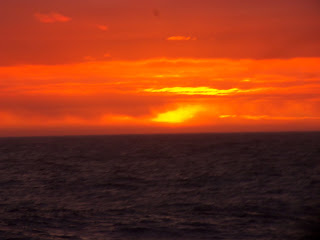Sunday, March 4In October, it was the Cape of Good Hope off the tip of Africa. Now, off the tip of South America, it's Cape Horn. Over there somewhere!



We were in Buenos Aires and Ushaia during Carnival celebrations, but did not get to see many of the festivities. Somehow we don't feel too deprived.
We disembarked from the Corinthian II after breakfast, and spent the day in Ushuaia. Surprise, surprise, I caught up on things Internet while Jan walked around town and looked in the shops.
In the late afternoon, we all met Carlos at a charming, genuine General Store to sample the local mate. Mate (Spanish pronunciation: [ˈmate], Portuguese pronunciation: ['mätʃi]), also known as chimarrão (Portuguese: [ʃimaˈhɐ̃w̃]) or cimarrón, is a traditional South American infused drink, particularly in Argentina, Uruguay, Paraguay, southern states of Brazil, south of Chile, the Bolivian Chaco, and to some extent, Syria and Lebanon. It is prepared from steeping dried leaves of yerba maté (llex paraguariensis, known in Portuguese as erva mate) in hot water.
Mate is served with a metal straw from a shared hollow calabash gourd. The straw is called a bombilla in some Latin American countries, a bomba in Portuguese, and a bombija or, more generally, a masassa (type of straw) in Arabic. The straw is traditionally made of silver. Modern, commercially available straws are typically made of nickel silver, called Alpaca; stainless steel, or hollow-stemmed cane. The gourd is known as a mate or a guampa; while in Brazil, it has the specific name of cuia. Even if the water is supplied from a modern thermos, the infusion is traditionally drunk from mates or cuias.
As with other brewed herbs, yerba mate leaves are dried, chopped, and ground into a powdery mixture called yerba. The bombilla acts as both a straw and a sieve. The submerged end is flared, with small holes or slots that allow the brewed liquid in, but block the chunky matter that makes up much of the mixture. A modern bombilla design uses a straight tube with holes, or spring sleeve to act as a sieve.[2]




Carlos explained the methods and rituals for consuming mate with friends. It's all about sharing and friendship. Even though it's a rather bitter balm!

 Mate is often taken with a sweet. Penguin pastries, anyone?
Mate is often taken with a sweet. Penguin pastries, anyone? There was no mistaking which restroom to use!
There was no mistaking which restroom to use!
 Ushuaia is a vibrant, frontier, port city.
Ushuaia is a vibrant, frontier, port city. And now we fly north to Iguazu Falls.
And now we fly north to Iguazu Falls.
We took a 10:30 flight from Ushuaia back to Buenos Aires, finally getting to our hotel at about 3:00 AM. Even sharing mate with Robin Williams wouldn't keep us awake at this point!
Monday, March 5After four hours of sleep, we got up early to go to the airport to fly to Iguazu Falls, in northeastern Argentina, the biggest, or one of the biggest, depending on how you measure, waterfalls in the world. Most people who have visited Victoria Falls and Niagra Falls say Iguazu Falls is the most magnificent.
We weren't disappointed!
Jan and I checked into the hotel and stayed back while all of the others in the group spent the rest of the day on the Brazil side of the falls. We thought $200 each for Brazilian Visas to visit for a couple of hours was a bit much, and we thought it would be nice to relax after the last unsettled day and a half with little sleep. The group had a good time, but most wished they had stayed back to relax and rest up. We would basically all do the same thing tomorrow morning that they did today, only on the Argentine side of the river/falls.
Jan took a photo or two.

 And had a swim.
And had a swim.
Our hotel was a hundred yards from the 3 Borders Monument. The water from Iguazu Falls flows via the Iquazu River to join with the Parana River, the junction being the border point between Brazil, Paraguay, and Argentina. Across the Iguazu from us was Brazil, and across the Parana from us was Paraguay. Each country has their own 3 Borders Monument.



 Across the river, to Jan's right, is Brazil
Across the river, to Jan's right, is Brazil
Across the bigger river to Jan's left is Paraguay
Jan took a photo!


Tomorrow, in the afternoon, we would take a wild boat ride on the river at the base of the falls. Yeehaw!
Next...



















































